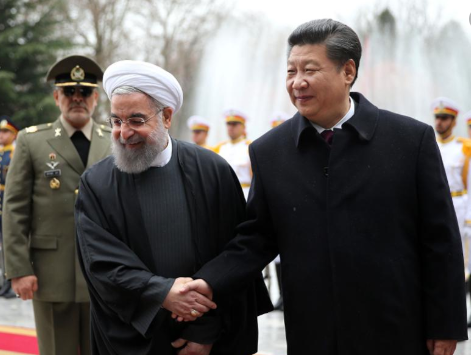Vali Nasr and Ariane Tabatabai
Iran says it is negotiating a 25-years’ agreement with China encompassing trade, energy, infrastructure, telecommunications, and even military cooperation. For Teheran, the prospect of a strategic partnership with China comes at a critical time. The Iranian government has been confronting popular discontent over a sinking domestic economy, which has been battered by American sanctions and, now, Covid-19.
Making matters worse, a recent series of explosions across the country has deepened the sense that the regime is under siege. Damaging at least two sites associated with the Iranian nuclear and missile programmes, these blasts appear to be part of a broader strategy by the United States and Israel to cripple Iran’s capabilities.News of a large deal with China is thus a welcome diversion for the Iranian government, and may even buy it time to maintain the status quo until the November 2020 US presidential election. The outcome of that contest will determine the trajectory of US-Iranian relations and the fate of the 2015 Iran nuclear deal, known as the Joint Comprehensive Plan of Action (JCPOA), while also influencing Iran’s own presidential election in June 2021.
To be sure, Iranians historically have been averse to aligning too closely with any great power, and they are even less willing to accept economic tutelage. With Iran’s relationship with China already a source of domestic controversy, it is possible that the country’s parliament will refuse to ratify the deal unless it is revised to meet certain concerns.
But Iran’s economy has been in a free-fall since 2018 after the Trump administration withdrew from the JCPOA and launched its “maximum pressure” on Teheran by imposing heavy sanctions designed to squeeze the regime. Moreover, with the regime as a whole facing a public backlash, President Hassan Rouhani’s government has been under tremendous internal pressure. The announcement of a deal with China allows Rouhani’s government to demonstrate that it is not putting all its eggs in the Western basket. The message to the Iranian people is they are not isolated, and may even enjoy economic improvements despite US sanctions.
At the international level, Iran has always sought to balance one great power against another. Over the past decade, in response to US diplomatic and economic pressure, its security forces looked to Russia, key economic sectors looked to China, and the Rouhani government reached out to Europe. Now, with Sino-American tensions rising, Iran is looking to China to shore up its economy and balance the US. Closer ties with China would give Iran more leverage in future talks with the US and Europe when it comes to revising or restoring the JCPOA, as well as in its dealings with regional rivals such as Saudi Arabia and the United Arab Emirates.
By contrast, a strategic partnership with Iran is a minefield for China. Although China continues to trade with Iran and invest in the country’s infrastructure, a deepening of ties could raise America’s ire at a critical and increasingly sensitive diplomatic juncture. By potentially exposing itself to US sanctions, China risks losing some access to the US market (which is far larger than that of Iran). Not surprisingly, Chinese officials have been relatively quieter about the negotiations than their Iranian counterparts have been. Likewise, China does not want to upset its regional partnerships with Israel or Saudi Arabia, each of which is currently engaged in proxy wars with and covert operations against Iran.
Nonetheless, China obviously sees some value in forging a comprehensive arrangement with Iran – a large, important regional player whose vast energy resources and tremendous economic potential make it a natural candidate for China’s westward-looking Belt and Road Initiative. China already buys discounted oil from Iran – not exactly a negligible benefit for the world’s foremost consumer of energy – and has become Iran’s key trading partner, including as a principal supplier of heavy machinery and manufacturing goods.
As part of this expansion, China could even gain control of the Iranian port of Chahbahar, which its main Asian rival, India, has been developing as a counter to China’s development of the nearby Pakistani port of Gwador. The Chahbahar port allows India to circumvent Pakistan – another rival – in its trade with Central Asia. But, despite the port’s recognized importance, US sanctions are forcing India out of Chahbahar and frustrating Iran. In fact, Iran is reportedly forcing India out of a railway project that bypasses Pakistan to connect with Afghanistan and Central Asia. News of that rupture came just after China and Iran announced a preliminary deal.
The recent border skirmishes between China and India show just how seriously China takes its footprint in West Asia. In addition to opening the door for China to control Chahbahar and monopolize trade routes into Central Asia, the Iran deal also appears to offer opportunities for China to develop naval facilities on the Gulf of Oman. Though the US has long wanted to shift away from the Middle East to focus more on China, the emerging Sino-Iranian deal reminds us that the two theatres are by no means separate.
By increasing pressure on both China and Iran, the US has encouraged the two countries to forge a common front. Though the Sino-Iranian relationship is still a long way from becoming a new axis, the recent negotiations show that such an arrangement is possible.
American foreign policymakers should take note. The US will need to try placing a wedge between China and Iran, which requires deciding which one poses the greater threat. Americans may want nothing more than to leave the Middle East once and for all. But the fact is that the strategic competition with China will not play out only in East Asia.
Vali Nasr is Professor of Middle East Studies and International Affairs at Johns Hopkins University’s School of Advanced International Studies. Ariane Tabatabai is a Middle East fellow at the Alliance for Securing Democracy at the German Marshall Fund of the United States. ©Project Syndicate.
